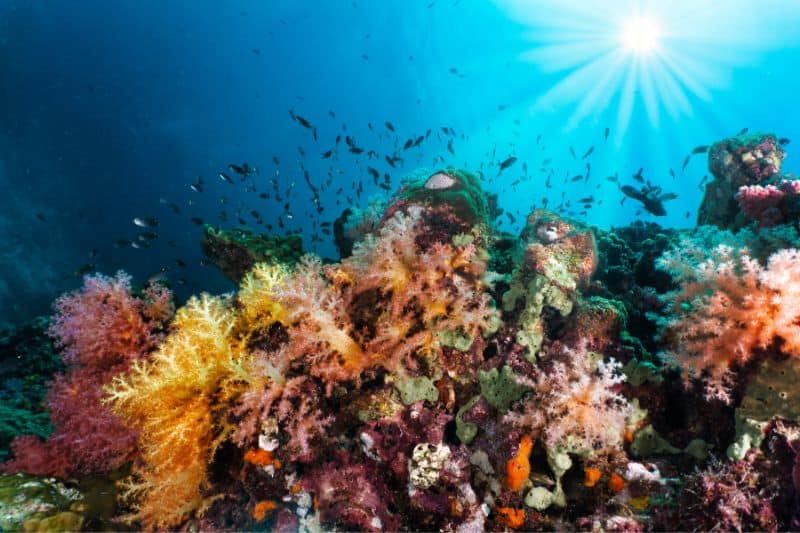It is widely believed that an ecosystem is more powerful and better equipped to sustain its existence amid external challenges if it has a greater variety of life.
This is because species in an ecosystem rely on one another for sustenance, maintaining a balance between birth and death rates that is sustainable for the ecosystem. Let us learn more about biodiversity and the ecosystem.
Benefits of Biodiversity in Ecosystems
An indicator of variation at the genetic, species, and ecosystem levels is biodiversity. It contributes to the ecosystem’s productivity, where each species plays a vital part, no matter how small.
For instance, a wide range of crops is implied by a vast number of plant species. Considering the extremely complex biosphere, about 90% of the species have yet to be discovered.
The persistence and sustainability of ecosystems depend critically on biodiversity. In the duties of organisms in an ecosystem, it serves as a catalyst. Humans also gain from biodiversity in many ways.
Below are some benefits of biodiversity in an ecosystem.
Carbon Sequestration
Removing and preserving carbon dioxide via the atmosphere is known as carbon sequestration. It lessens carbon dioxide in the atmosphere, and its ultimate objective is reducing climate change.
Carbon dioxide is removed from the atmosphere by soil and vegetation in ecosystems such as forests, kelp beds, peatlands, wetlands, seabeds, and grasslands.
Food Security
Agriculture and our food system are closely related to biodiversity. Millions of species collaborate to provide us with a wide range of cereals, animal products, fruits, and vegetables. Biodiversity’s multiple “services” are essential to food production.
This includes pollination, water filtration, soil fertility maintenance, climate maintenance, and pest and disease resistance. Bee losses could cost the UK’s agricultural sector up to $812 million a year and jeopardize the nation’s food supply.
Disease Resistance
Populations with various ancestries are more likely to survive a pandemic or other disaster. Diverse communities contain genetic codes that reduce some members’ susceptibility. The species’ survival is assured through the transmission of disease resistance when people with these genetic codes procreate.
Flooding, Storms, and Coastal Erosion Regulation
The World Economic Forum estimates that by the century’s conclusion, 410 million individuals could be impacted by increasing sea levels along coastal areas. While tropical Asia is predicted to experience 59 percent of the sea level rise, other nations, including China, Nigeria, France, the United States, and Senegal, are similarly at risk.
Flood avoidance for low-lying coastal settlements will include the regeneration and preservation of coastal habitats, including mudflats and salt marshes. Microorganisms and salt marsh plants stabilize and bind the soil.
When combined with more root biomass, these habitats can offer superior soil erosion resistance. Coastal towns vulnerable to typhoons are protected by ecosystems like seagrass and coral reefs that act as a buffer against tides or storms.
Types of Biodiversity
Genetic diversity, ecosystem diversity, and species diversity are the three basic categories of biodiversity. Let us take a closer look into how each of them functions to comprehend how biodiversity keeps life on Earth completely.
Genetic Diversity
The wide range of genes found within a particular species is genetic diversity. It examines diversity at the DNA level. Genes are the fundamental components of inheritance, and DNA serves as the basis for genes.
Its genes determine the physical characteristics of a species. One species may consist of various populations with various genetic make-ups. Small variations exist in the DNA base sequences of humans, for instance.
These variations influence a person’s distinctive physical characteristics. Increased levels of interpretation are also seen among residents of different areas.
Ecosystem Diversity
The broadest definition of biodiversity is ecosystem diversity. It depicts the diversity of habitats or ecosystems within a given geographic area. A population of organisms that interact with one another and their surroundings is referred to as an ecosystem.
It can range in size from a pond to an ocean. In contrast to the other two categories of biodiversity, ecosystem diversity considers biological and non-biological factors. Communities are formed in places with high ecosystem biodiversity that are more protected against abrupt changes.
Species Diversity
The number and spread of organisms in a habitat are called species diversity, the wide range of species seen inside an area or region. Depending on the surrounding circumstances, the number changes.
It is a blessing that so many species exist in habitats like rainforests and coral reefs. A desert, however, has less biodiversity because of its high temperatures and little rainfall.
Additionally, species diversity considers the functions each species performs within its ecosystem.

How is Ecosystem Sustainability Maintained By Biodiversity?
The sustainability and persistence of ecosystems depend critically on biodiversity. In the function of species in an ecosystem, it serves as a catalyst. An indicator of variation at the genetic, species, and ecosystem levels is biodiversity.
It contributes to the ecosystem’s productivity, where each species plays a vital part, no matter how small. For instance, a wide range of crops is implied by a vast number of plant species.
Since the biosphere is extremely complex, about 90 percent of the species have yet to be discovered. There is a common misconception that greater biodiversity promotes sustainability or that it protects against external pressures.
This is because all species are dependent on one another for sustenance, balancing birth and mortality in a way that ensures the ecosystem is sustainable and healthy.
The ecosystem would not be affected if one or more species that do not play a critical role in maintaining the ecosystem suddenly disappeared. However, an ecosystem would become considerably weaker if the species vital to its sustainability went extinct.
Keystone Species are commonly referred to as species that significantly impact an ecosystem.
How Does Biodiversity Contribute to the Sustainability of a Habitat?
Since a healthy ecosystem includes several trophic levels of decomposers, consumers, and producers, biodiversity helps ensure a habitat’s sustainability.
Every element that an animal or plant requires for survival, including food, shelter, and water, is provided by a habitat. Forest animals require various environments to provide for their needs in terms of food, water, and shelter.
In addition to preserving genetic variation across and within species populations, forests promote ecological diversity. ‘Biodiversity hotspots’ are ecosystems with an unusually high number of species, making them more genetically varied than others.
Various Factors Affecting Biodiversity
Different variables have an impact on biodiversity. Loss of habitat, invasive species, climate change, pollution, and overfishing brought on by global warming are all factors in biodiversity decline.
Climate Change
The Earth’s average temperature has risen over the past 200 years, which is known as global warming. The atmosphere’s rising levels of methane, carbon dioxide, and other greenhouse emissions are to blame for the rise in temperature.
As a result of disrupting the seasonal cycle, global warming has caused variations in climate in many places.
Natural Disasters
Storms, floods, and droughts wreak havoc on ecosystems, destroying food sources and habitats. Additionally, they might alter the food chain, making it challenging for animals and plants to reclaim the area.
Additionally, droughts have the power to quickly wipe out large areas and spark wildfires that can severely harm biodiversity. Biodiversity can suffer greatly from natural calamities, including volcanoes, droughts, forest fires, hurricanes, epidemics, floods, and tsunamis.
Invasive Species
A significant contributor to extinction, particularly on beaches and freshwater ecosystems, invasive alien species remain an issue worldwide. On islands, it has been the main reason for extinction during the past 20 years and the second biggest reason for species extinction in freshwater ecosystems.
The need to stop the spread of invasive alien species is becoming more widely recognized, yet effective preventive measures still need to be implemented. The extent of introductions is still very high; for instance, since European arrival in New Zealand in 1840, 11 species of plants have been introduced annually.
Pollution
Both humans and other animals are harmed by air pollution. It impacts the respiratory system and health and alters spawning propensity and behavior. Substantial greenhouse gas releases like carbon dioxide, nitric oxide, and methane quickly alter the planet’s temperature.
Biodiversity has been negatively impacted by water contamination. Phosphorus and nitrogen are typically found in chemical fertilizers given to the soil to boost agricultural productivity. These then enter the lakes and other bodies of water and contaminate them.
Another element that has a negative effect on biodiversity is soil contamination. The health of the microorganisms necessary for maintaining living beings’ lives is significantly impacted by heavy metal contamination of soil.
Habitat Loss
When a species’ natural habitat is severely damaged, it becomes impossible to preserve the native ecosystem and the species that depend on it. In the end, this causes species extinction.
The primary cause of this extinction is deforestation. When forests are cut down to make way for homes and businesses, a significant amount of habitat is lost.
Conclusion
The foundation of life on the planet is provided by biodiversity at its most basic level. Ensuring advantages like fresh water, pure air, healthy, productive land, and other things. Ecosystems rely on sustainability to continue ecological processes.
The ecosystem’s ability to support biodiversity is essential to supporting human life. The human species would cease to be able to thrive on Earth if many species went extinct or if our environment failed.






